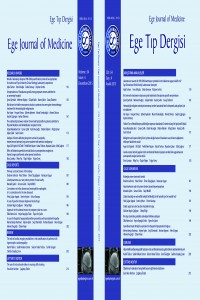Risk factors for febrile neutropenic attacks in patients who were given chemotherapy treatment for hematological malignancies
Abstract
Aim: Febrile neutropenic attacks are an important problem during and after chemotherapy. We retrospectively reviewed the records of patients who were administered chemotherapy treatment to identify the risk factors for febrile neutropenic attacks. Materials and Methods: A total of 261 inpatient periods that included 154 patients (92 male and 62 female) between 2004 and 2006 were analyzed retrospectively. The median age was 49.5 (range, 17-80) years. Patients' clinical and demographic data were collected. We analyzed the relationship between febrile neutropenic attacks and clinical variables (diagnosis, age, sex, chemotherapy regimen, stem cell transplantation, the length of the neutropenic period, the presence of central venous catheter, and granulocyte colony stimulating factor [G-CSF] use) by a stepwise logistic regression model. Results: Febrile neutropenic attacks were detected in 201 (77%) inpatient periods. A diagnosis of acute leukemia (OR: 3.36, 95% CI: 1.16-9.78, p=0.02), stem cell transplantation (OR: 8.77, 95% CI: 2.41-31.821, p=0.001), G-CSF use (OR: 8.46, 95% CI: 3.28-22.04, p=0.000) and length of the neutropenic period ≥ 10 days (OR: 4.01, 95% CI: 0.83-19.24, p=0.001) were risk factors for febrile neutropenic attacks. Conclusion: Acute leukemia, stem cell transplantation, length of the neutropenic period ≥ 10 days and treatment with G-CSF were the most important risk factors for febrile neutropenic attacks. The result that G-CSF was a risk factor for febrile neutropenia was attributed to the fever-inducing effect of this drug. The use of G-CSF should be questioned in neutropenic patients with fever, especially in those without signs and symptoms of infection.
Hematolojik malignite nedeniyle kemoterapi verilen hastalarda febril nötropenik atak gelişimi için risk faktörleri
Abstract
Amaç: Febril nötropenik ataklar kemoterapi sırasında ve sonrasında önemli bir problemdir. Biz febril nötropenik atak için risk faktörlerini saptamak için kemoterapi alan hastaların kayıtlarını geriye dönük olarak inceledik. Gereç ve Yöntem: Toplam 154 (92 erkek ve 62 kadın) hastanın 2004-2006 yılları arasındaki 261 yatış periyodu geriye dönük olarak analiz edildi. Ortanca yaş 49.5 (17- 80) idi. Hastaların klinik ve demografik verileri toplandı. Febril nötropenik atak ve klinik değişkenler (tanı, yaş, cinsiyet, kemoterapi rejimi, kök hücre transplantasyonu, nötropeni süresi, santral venöz kateter varlığı ve G-CSF kullanımı) arasındaki ilişki logistic regresyon modeli kullanılarak analiz edildi. Bulgular: Febril nötropenik atak 201(% 77) yatış periyodunda saptandı. Akut lösemi tanısı (OR: 3.36, % 95 CI, 1.16- 9.78, p: 0.02), kök hücre nakli (OR:8.77, %95 CI,2.41-31.82, p:0.001), G-CSF kullanımı (OR: 8.46, 95% CI, 3.28- 22.04, p: 0.000) ve nötropenik periyodun ≥ 10 gün olması (OR: 4.01, % 95 CI, 0.83- 19.24, p: 0.001) febril nötropenik atak için risk faktörü olarak saptandı. Sonuç: Akut lösemi, kök hücre nakli, nötropenik periyodun 10 günden uzun olması ve G-CSF kullanımı febril nötropenik atak için risk faktörü olarak saptanmıştır. G-CSF'nin febril nötropeni için risk faktörü olması ilacın ateş yapıcı etkisine bağlanmıştır. Özellikle infeksiyon semptom ve bulgusu olmayan febril nötropenik hastalarda G-CSF kullanımı sorgulanmalıdır.
Details
| Other ID | JA76BY73AV |
|---|---|
| Journal Section | Research Articles |
| Authors | |
| Publication Date | December 1, 2015 |
| Submission Date | December 1, 2015 |
| Published in Issue | Year 2015 Volume: 54 Issue: 4 |

